Lobstermen: Maine Fishery Doesn’t Harm Right Whales
Continued from Homepage

More than 200 fishermen, interested legislators and citizens attended the right whale entanglement information and public comment meeting at the Ellsworth High School auditorium on August 13, 2019. The meeting was one of four NOAA sponsored meetings held in Maine in August. The NOAA whale take reduction team said the meetings were held, among other things, to gather information from fishermen about what they can and cannot do to reduce whale interaction with their lobster gear. Fishermen’s Voice photo.
“We’re not only dealing with the lives and livelihoods of our fishermen and their crewmen, the dock workers, the buyers, the dealers, the entire industry,” Eaton said. “We’re also dealing with the lifeblood of our island and coastal communities. We don’t have Wal-Mart, we don’t have McDonald’s. We’re little small fishing communities. We have lobstering.”
She added, “It’s not only what we do. It’s who we are. We are custodians of the ocean. We don’t want right whales to go extinct. We have complied with everything you have asked of us. But this ask is way too big.”
The data are clear
that Canadian vessel
strikes and entanglements
are now the most significant
cause of right whale
serious injury and death.
– Patrice McCarron, Maine Lobstermen’s Association
Halving the number of endlines would result in trawling up more traps on a line. That would be dangerous, Eaton said.
“All that additional rope on the boat is dangerous and people will die,” she said. “Go back to the drawing board. Come before us with relevant science.”
The remarks came during a scoping meeting held in Ellsworth on Aug. 13 by the Greater Atlantic Regional Fisheries Office (GARFO). It was one of eight scoping meetings held from Maine to Rhode Island; four of the meetings were held in Maine. The meetings were held in anticipation of preparing a Draft Environmental Impact Statement for modifications to the Atlantic Large Whale Take Reduction Plan.
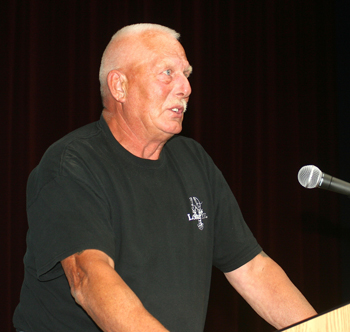
“All of our communities could dry up and blow away,” Rocky Alley, president of the Maine Lobstering Union, said during a scoping session on proposed gear modifications. Laurie Schreiber photo.
The goal of the sessions was to get comments on management options, particularly including information about operational challenges, time, and costs required to modify gear by changing configurations such as traps per trawl to reduce endline numbers, installing new line or sleeves and by expanding gear marking requirements.
The proposed modifications result from a decline of the endangered North Atlantic right whale p population.
The agency’s goal is to reduce serious injuries and deaths from entanglements in lobster trap gear by 60 to 80 percent.
At the meeting, Michael Asaro with the Greater Atlantic Regional Fisheries Office in Gloucester, Mass., said federal law pertaining to endangered species requires action to reduce human impacts if deaths in a population exceeds certain limits, called the potential biological removal (PBR). In the case of the North Atlantic right whale, that limit is nine-tenths, or less than one death per year. There have been 28 known deaths in U.S. and Canada waters over the past three years. Compounding that problem is the low number of females of reproductive age, he said. It’s estimated that there may be 400 or fewer right whales; of that, it’s estimated there are 95 females of reproductive age.
Factors causing death and injury include ship strikes and entanglements in Canada and the U.S., he said.
Habitat use and distribution have changed a lot in the past decade due to new stressors that include warming ocean waters, he said. There’s been a substantial increase in the presence of right whales in the Gulf of St. Lawrence since 2015. That’s resulted in a high rate of deaths in the Gulf of St. Lawrence due to increased exposure to Canadian fisheries and vessel traffic.
Fishermen wanted to hear about the evidence of right whale presence in the Gulf of Maine. Asaro said right whales can be easily spotted when they’re in large groups in their breeding and feeding areas. But they don’t aggregate when they migrate. That makes them difficult to spot, which puts them at highest risk.
Passive acoustic buoys have detected their calls in the Gulf of Maine, he said.
“There’s lot of uncertainty
and limited predictability
about where whales will
be in the future.”
– Michael Asaro, ALWTRT
Right whales are almost never anchored in place once they’re entangled, Asaro said.
“They carry the gear great distances,” he said. “We ‘ve seen them with Canadian crab pots off the Florida and Georgia coast….There was a right whale earlier this year first seen entangled in the Gulf of Maine. It was spotted a few months later in the Gulf of St. Lawrence, still entangled”
In 2018, he said, three documented mortalities showed signs of entanglement that was first seen in U.S. waters.
Since 1980, there have been over 1,400 documented entanglements of right whales. Gear was recovered from a portion of those entanglements. Unique gear marks allowed gear to be traced back to specific fishermen only 13 times. The locations of those trace-backs were spread from Cape Cod to the Bay of Fundy and the Gulf of St. Lawrence, with several points along the Maine coast. The retrieval of Maine gear did not occur in recent years.
Predicting right whale distribution will become more challenging with increasing environmental variability, Asaro said.
“There’s lot of uncertainty and limited predictability about where whales will be in the future,” he said. “Where they were in the past is no longer a good indicator of where they’ll be in the future.”
One fisherman wanted to know if ship strikes count against fishermen. GARFO Take Reduction Team Coordinator Colleen Coogan said the way that other industries and mortalities affect the take reduction plan is that, if the population declines, the potential biological removal number goes down. Because of the number of right whale deaths in recent years, it’s expected the next stock assessment will identify the PBR at eight-tenths per year, rather than the current rate of nine-tenths per year, she said.
Fishermen also wanted to know if the agency had taken into account the dangers of underwater seismic testing to right whales.
Fishermen said a system of gear marking should be established and allowed to operate for a year or two, in order to reduce uncertainty around where the whales are getting entangled.
“We needed to have our own color separate from any other state or country years ago,” said Alley. “Then you could have the evidence to present to us that we are the problem, not throw it at us now. It wasn’t very good forward-thinking on NOAA’s part. Now here we are, getting thrown under the bus again. We are not the problem.”
Richard Larrabee Jr., a Stonington fisherman, said his community depends on the lobster industry.
“If they wanted to save the whales, they wouldn’t be targeting the lobster industry. They’d be targeting the shipping industry,” he said.
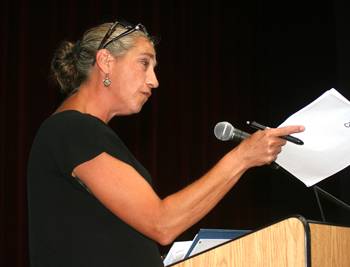
Virginia Olsen, a Stonington fisherman and member of the Maine Lobstering Union, said economic impacts on fishermen of proposed gear modifications need to be analyzed. Laurie Schreiber photo.
Virginia Olsen, a Stonington fisherman and member of the Maine Lobstering Union, said that among the data to be analyzed is the potential economic costs of moving to bigger boats if larger trawls are going to be required.
“What are we going to do with the boats we have now?” she said. “Are we going to now have a boat in a size that’s obsolete? I’d like to have someone look into what we are going to do with this size boat that could be obsolete, and what’s going to happen with financial institutions if we’ve got to borrow money to buy a boat.”
Olsen also wanted an analysis of how Stonington would make up for loss of revenue if lobstermen are forced out of the business. Most of Stonington’s economy is generated from the lobster industry, she said.
“If we’re going to make that deep a cut into our economy, how are we going to make that up?” she said. “We don’t have any other place to go for employment. We have lobster fishing. Those are things we need to look at.”
The proposed regulations are already impacting the ability of lobster fishermen to invest in their businesses, she noted. Earlier this year, she said, she was looking to buy new traps.
“When we went to make that investment, one of the first things they asked us was, ‘Are you sure you want to make this investment with the coming changes in the lobster industry?’” she said. “They were asking about the whale regulation. So if they were asking us that six months ago, what’s that going to mean for our industry? I think that’s something we need to look at moving forward.”
Kathleen Billings, Stonington’s town manager, said the town is the largest lobster port in Maine.
“We’re a feisty little fishing town of 1,043 for population and 450 to 500 boats,” Billings said. “Over half of our workforce is employed directly or indirectly in the lobster industry, plus workers come from surrounding towns.”
With one of the largest fishing fleets in Maine, the proposed rules are a concern for Stonington, she said, adding that the regulatory framework doesn’t take into account the economic health and vitality of local towns and cities.
“We are not going to be able to survive this economic disaster that you’re proposing,” Billings said.
And a reduction in endlines will cause huge safety concerns, she said.
“We come from a rocky and tough bottom with heavy tides and currents, which makes longer trawls unsafe or impractical,” she said. “We should not be penalized for where we fish.”
Billings added, “Nobody in our town wants to hurts whales. And we aren’t.”
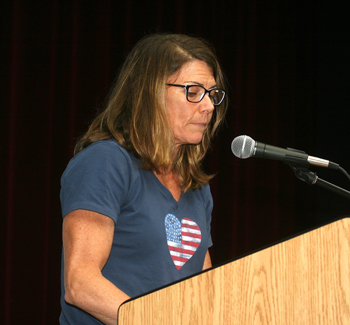
Maine Lobstermen’s Association Executive Director Patrice McCarron said the association “is acutely aware right whales are endangered and is committed to help the species recover.” But there has been only one confirmed right whale entanglement in Maine lobster gear dating back to 2002, and no known serious injuries or mortalities. Laurie Schreiber photo.
In a written statement, Maine Lobstermen’s Association (MLA) Executive Director Patrice McCarron said the association “is acutely aware right whales are endangered and is committed to help the species recover.”
There has been only one confirmed right whale entanglement in Maine lobster gear dating back to 2002, and there are no known serious injuries or mortalities, she said.
“If right whales are at unique risk when they venture into Maine waters, that would have been documented by the [Take Reduction Team] since its work began,” she said. “But more than 22 years of research and observation show no such heightened risk.”
Recent scientific work shows that the right whale decline is driven by changing environmental conditions resulting in a dramatic shift in right whale distribution and migratory patterns, she said.
“The data are clear that Canadian vessel strikes and entanglements are now the most significant cause of right whale serious injury and death because right whales are spending significantly more time in Canada’s largely unregulated waters,” she said. “A complete shutdown of the Maine lobster fishery would not have prevented the spate of right whale deaths occurring primarily in Canada since 2016.”
While right whales continue to utilize U.S. waters, their distribution patterns have changed, she said.
“More than half the population of right whales are now regularly sighted feeding in Massachusetts waters in and around Cape Cod Bay, and a significant new habitat has been identified south of Nantucket,” she said, “While dense aggregations of right whales continue to increase in Massachusetts waters, the number of right whales detected along the Maine coast has declined since 2010.”
The MLA rejects the 60 percent risk reduction goal for Maine, she said. Instead, the MLA asked federal regulators to adopt scoping priorities reflecting the decline in entanglement cases observed in U.S. lobster gear since 2010 and develop priorities that address more pressing risks; and to reconsider its evaluation of other threats to right whales and their habitat such as seismic testing, offshore wind developments, and offshore aquaculture.
She said MLA supports measures to help right whales and to further understanding of the species and the risks it faces. That includes expanded and unique gear marking for Maine, expanded harvester reporting, investment in the development of a long-term tagging device to improve data on right whale distribution, increased right whale surveillance in regulated waters, permanent funding for long-term plankton monitoring and development of right whale habitat suitability models.
“A 50 percent endline
reduction requires the
lion’s share of the burden
to fall on the inshore area,
where we know the benefit
to whales will be minimal.”
– Pat Keliher, Commissioner,
Maine DMR
In his remarks, Department of Marine Resources (DMR) Commissioner Patrick Keliher said the proposed regulations “have the potential to dramatically impact this fishery and the state of Maine.”
The vast majority of the Maine lobster fishery takes place close to shore, with over 70 percent of vertical lines occurring within the existing exemption line. The exemption line has been upheld by federal regulators previously because it is the inshore boundary of the Maine coastal current, an oceanographic feature for the transport and distribution of a key food source for right whales, a type of zooplankton called Calanus finmarchicus. Low concentrations of Calanus shoreward of the exemption line are unlikely to support right whale aggregations, Keliher said.
“In fact, exempted waters are not included in the critical habitat for right whales for this reason,” he said. As a result, he said, the state “believes it is imperative for NOAA to consider the exemption line in its rule-making given the science shows that regulating exempted waters would not have a significant benefit to right whales.”
In addition, Keliher said, data supports the statement that the Maine lobster fishery is not a primary source of right whale serious injury and mortality.
Understanding the diversity of Maine’s lobster industry is paramount to developing any future regulations, he said.
“This includes not only the range of vessels from small skiffs to the larger boats but also the diversity of fishing practices from the western to the eastern ends of the state,” he said. He asked regulators to consider developing a rule to allow conservation equivalencies in more discrete areas, whether by zone or sub-region, in light of the distinctions in fishing practices and geographic features across the Gulf of Maine.
A 50 percent endline reduction, he said, “requires the lion’s share of the burden to fall on the inshore area inside the exemption line, where we know the benefit to whales will be minimal. From a pragmatic standpoint, this is not a defensible approach.”
The Maine lobster fishery has actively participated in the conservation of marine mammals for over 20 years, Keliher added. “The attendance here tonight demonstrates the industry’s continued commitment to engage in difficult conversations,” he said.
The department held its own series of meetings with lobstermen throughout the state in June, and plans to do so again starting in late August, Keliher said.
U.S. Senator Angus King said no fishery is more conservation-minded than the lobster fishery. King said he’s concerned about preservation of the right whale. But, he said, he’s concerned the proposed rules don’t hit the right target.
“When most of these rule changes affect the Gulf of Maine, where it doesn’t appear the whales are, it’s like bombing Brazil after Pearl Harbor,” he said.
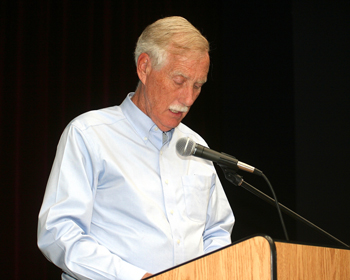
“When most of these rule changes affect the Gulf of Maine, where it doesn’t appear the whales are, it’s like bombing Brazil after Pearl Harbor,” said U.S. Senator Angus King. Laurie Schreiber photo.
King said gear-marking should be implemented immediately and allowed to run a year or two in order to determine whether or not Maine’s lobster gear is impacting the right whale. He added that Canada must be involved in parallel efforts.
“We can work with them diplomatically,” King said. “That ought to be one of the highest priorities, because that looks like the hot spot.”
Zack Klyver, a long-time naturalist with Bar Harbor Whale Watch and Blue Planet Strategies LLC, has spent 30 years studying whales in the Gulf of Maine. During that time, he said, researchers have sighted right whales on about 120 whalewatching trips over the course of three decades. Almost all sightings were in deep offshore waters. Klyver said he and his colleagues would make the long-term data set public, in order to contribute to a better understanding of where and when right whales are in the Gulf of Maine. That could contribute to an understanding of whether temporary fishing closures could be implemented as a conservation tool, as a potential alternative to reducing endlines.
“Trawling up inshore isn’t going to reduce risk,” Klyver said. “In midcoast and downeast Maine, it’s a rare occurrence for a right whale to come inshore.”
Steve Katona, a long-time marine mammal researcher and former president of Bar Harbor’s College of the Atlantic, said right whales transit the whole Gulf of Maine because they’ve got to get from their breeding areas to the south up to their feeding areas in the north.
“We don’t want right whales to go extinct and we certainly don’t want fishing families to go extinct,” Katona said. “Loss of North Atlantic right whales would be a wildlife catastrophe – a preventable one at this point. It would also be a social catastrophe, because if the whalesreach a critical point, existing legislation would almost certainly require closure of any fishery using standing lines. Nobody wants that. So the clearest way to prevent both those catastrophes is to confront the facts squarely and begin to take action now.”
Katona said he’s convinced that the ultimate goal must be to convert all trap and line fisheries throughout the range of the right whale to ropeless technology.
“Those technologies are in development now; they’re certainly not ready for prime time,” he said. “They’ll require several years of further testing to make sure they could work. Then I recommend a phased period of deployment.”
Conversion to ropeless fishing would be expensive, he said.
“I don’t think fishermen should bear that cost,” he said. “This is a national goal, to preserve right whales. The conversion costs should be subsidized primarily by federal and state government but also through modest ropeless surcharge on lobsters and crabs, to be paid by consumers. Fishermen shouldn’t have to bear the initial costs of conversion. Although later, as the technology becomes less expensive, then it might become part of the regular fishing budget.”
Kim Ervin Tucker, attorney for the Maine Lobstering Union, said the greatest risk to endangered species is a regulatory processes like the one now underway, “where agencies are selecting out an industry that has little to nothing to do with the problem, choosing them as low-hanging fruit over and over again,” she said. “There’s constant moving of the goal post.”
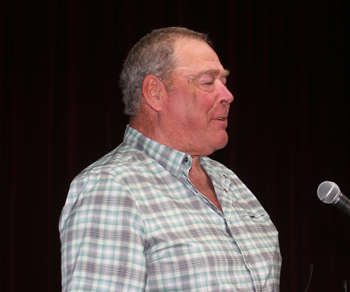
“There’s got to be a better way to do this,” fisherman John Williams said. Laurie Schreiber photo.
The agency aims to have a proposed rule drafted by the end of 2019 and to have it available for public comment in early 2020.
Written comments are also welcomed. Comments are due by Sept. 16. Submit electronic public comments by sending an email to gar.ALWTRT2019@noaa.gov using the subject line “Comments on Atlantic Large Whale Take Reduction Plan Scoping.”
Submit written comments to Michael Pentony, Regional Administrator, National Marine Fisheries Service, 55 Great Republic Drive, Gloucester, MA 01930-2276. Mark the outside of the envelope: “Comments on Atlantic Large Whale Take Reduction Plan.”
In related developments, NOAA Fisheries Assistant Administrator Chris Oliver recently met with officials from Canada’s Department of Fisheries and Oceans and Transport Canada to coordinate conservation and management efforts for the North Atlantic right whale, according to a press release.
“We have already been coordinating closely with Canada to share innovative techniques and solutions that foster healthy fisheries, reduce the risk of entanglements, and create whale-safe shipping practices,” Oliver said in the release. “We requested this special meeting because the situation has become even more alarming with the recent discovery of eight dead and four entangled North Atlantic right whales in the Gulf of St. Lawrence in Canada.”
The parties discussed measures both countries have undertaken to reduce risk as well as plans for new measures in the future and the need for equity in these measures on both sides of the border.
“Over the next few months, we will coordinate with Canadian officials on future gear marking schemes in order to improve the ability to identify the source of gear seen on or retrieved from large whales along the eastern seaboard,” he said.” We will also continue to work with them to identify data and management gaps that are impeding recovery of right whales both in Canada and in the U.S.”
